Komodo National Park Funny Yahoo Answers
Written by Kristyna Schonova
Many people say that Flores is distinctly different from the rest of Indonesia. There's something unique and exotic in these untouched lush green hilly landscapes dotted with villages, where centuries-old tradition and heritage are still preserved and are still very real as part and parcel of the locals' lifestyle.
When we first stepped into Flores (which means 'flower' in Portuguese), we were very heartened by the friendly locals, and it often felt as though we were some of the few rare foreign travellers there. People were smiling and kids were calling out "Hello how are you?" every time we passed through a local village.
Also read:
The ultimate guide to Komodo islands and Flores – Indonesia's land of dragons
19 out-of-this-world hiking trails in Indonesia with the most incredible views
Here, the most delicious grilled fish isn't served in an expensive restaurant but in a simple warung on the shore. You will hardly find any luxurious resorts, but if you want to see and experience the local life with all its traditions, Flores is a place for you.
Getting there Getting Around When should you go?
From Bali
Take Sriwijaya Air, Lion Air or Garuda Indonesia from Ngurah Rai International Airport, Bali to Labuan Bajo Airport, Flores. (Flight time: ~1h 20min, total return cost from Rp 2.1 mil)
From Jakarta
Take Garuda Indonesia from Soekarno Hatta International Airport, Jakarta to Labuan Bajo Airport, Flores. (Flight time: ~2h, total return cost from Rp 1.9 mil)
The first stop for most tourists is usually the port village, Labuan Bajo.
From there, you can organize a boat trip to Komodo National Park, other islands or some diving spots. You can also find a guide and explore the further west and end your trip in another city where you can fly out directly (such as Maumere and Ende, which have airports).
Public transport in Flores is usually very crowded, slow and unreliable, so the easiest way to travel around is to hire a car with a driver and go on a road trip. The trans-Flores highway connecting the west with the east is generally pretty well-maintained, but when you venture into smaller roads, be prepared for rocky paths that may be a little dangerous at times, so if you are just renting a bike, do be careful!
In Flores. the wet season starts in December and the rains last until March, and from April to November you can expect hot dry summer.
If you want to avoid tourists and still enjoy good weather, plan your trip from April to June before the high season starts, or from September to November, after it ends. Keep in mind that some attractions such as waterfalls, hot springs or mountain hikes may not be accessible during the wet season.
Regardless of whether you're a diver, beach person, passionate hiker, or purely interested in geology, archeology or traditional cultures, Flores will have something for you.
Let us show you the most exotic wonders Flores has to offer. Are you ready for the adventure?
1. The coolest place for swimming: Rangko cave (near Labuan Bajo)
Few have heard about this recently discovered four-metre-deep cave, which hides a splendid natural pool with cold, crystal clear water. The water contains a large amount of salt, so you can actually take a healthy bath!

Photo Via Esperanza.putri
What else can you find there? Nature's beautiful works of art, such as stalactites, stalagmites or fossils hidden in the cave walls.
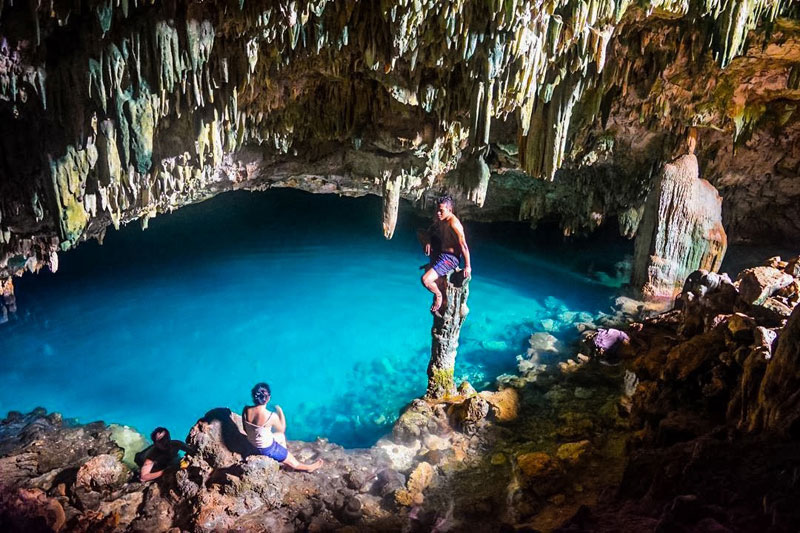
Photo Via Angelinolazar
When the sunlight filters into the cave and the water begins to sparkle, it's difficult to imagine a better pool to swim in!

Photo Via Cnlulaby
Rangko cave
Address: Tanjung Boleng, Boleng, West Manggarai Regency, East Nusa Tenggara
Getting there: The easiest way is to take a boat from Labuan Bajo (it takes about 45 minutes) or you can first go by car to Rangko village (around 45 minutes), take a boat to the beach (10 minutes) and finally walk to the cave in 5 minutes.
2. Stay in a cute bamboo bungalow by the sea: Maumere Coconut Garden Beach Resort
Looking for an accommodation in Maumere? Lay your head in one of these funky bamboo bungalows.

This resort has a semi-open gym, wicked swings, hammocks, and it's right on the beach!


Photo Via Renzadea

Photo Via Meithashfly
Under the bamboo penthouse, you'll find a restaurant, where you can indulge in its specialty seafood and marvel over its creative food design.

Photo Via Estitanaem,Yenny_cdr

Photo Via Theblondeabroad,Peterirman
If you are keen to do activities such as horse riding, snorkelling and fishing or tour around Flores, the staff could help you organise them.
Maumere Coconut Garden Beach Resort
Rate: Rp. 1,200,000 (USD 89) a night for Beachfront bungalow
Address: JL. Nasional Larantuka 15km, Maumere, Nusa Tenggara Timur, Indonesia
Contact: Tel: 62 82144260185, Email: [email protected]
Website:
Check Rate on Agoda
3. Adventure to the 3 Multi-coloured Lakes – Mount Kelimutu, Flores
Mount Kelimutu's three multi-coloured volcanic lakes, the crown jewels of Flores, offer hikers a bright reward.

Photo Via: iramrizkyn
Each of the three lakes has its own colour, ranging from vibrant blue to muddy brown. The lakes can change colour several times a year.

Photo Via: holykaw alltop
As the top of Mount Kelimutu is often covered by impenetrable fog, hikers must begin early to reach the summit by sunrise. Most often, hikers catch an 8-seater truck version of public transportation between 3:30 and 4 AM. This truck drops passengers at the Kelimutu National Park parking lot. From there, it is a well-marked, 30-minute climb.

Photo Via: lyladventure
Those who suffer from motion sickness might want to consider the longer hike. A 20-kilometre path leads to the lakes from Moni village. This takes at least 4 hours to climb.
Kelimutu National Park is well-known these days, but the view of the three lakes from its only hike is so magnificent, you shouldn't miss it even if you're only looking for off-the-beaten paths.
Mount Kelimutu
Difficulty Level: 6/10
Address: Moni, Flores, East Nusa Tenggara, Indonesia
Entrance fees: IDR $150,000 (USD $11) per person
Getting there: The nearest airport to Kelimutu National Park is Frans Seda Airport in Maumere. From Maumere, visitors need to take the Maumere-Ende bus and alight in Moni. Alternatively, take a taxi from Maumere to Moni. From Moni, visitors can either walk 20km to the lakes or catch public transportation or a taxi to the Kelimutu National Park parking lot for a shorter hike. Coordinates here
Official Website
4. Watch the traditional Caci Whip Fight in Manggarai!
If you happen to be in Flores in mid-August, come visit Manggarai to watch this unusual ritual.
Caci is a whip fight performed by two men, who are usually from different villages. The fighters are egged on by the yelling spectators as they dance to drum and gong music

Photo Via Tatik.hadiatmo
And mind, this dance-fight is symbolic as well. The aggressor's rattan whip symbolizes the male meanwhile the defender's round shield represents the female element. Whenever the whips meet, the female and male elements are united.
During the dance, fighters wear a woven cloth called Songket, while their chest remains uncovered.
The fighter who is first hit in the face or on the head loses the game. As you may have guessed, the Caci dance can sometimes be quite bloody, but the villagers see it as a sacrifice to the gods and ancestors.

Photo Via Angga.yoga
Caci is performed during weddings, births and funerals. It's an important social event and also a way to resolve conflicts between disputing villages. You'll also have a chance to watch the Caci during the Penti festival from July to November.
Address: Lapangan Motang Rua Field, Ruteng Mbaumuku, Langke Rembong, Manggarai Regency, East Nusa Tenggara
5. Uncover the secrets of the dwarves: Hobbit cave (Liang Bua cave) (near Ruteng)
Take a little trip 100,000 years back into the past.
This cave was first excavated in 1965 by Dutch priest Father Theodor Verhoeven. However, it was only in 2003 when the skeletal remains of small humanoids were uncovered a few metres under the ground!

Photo Via Vash1029
Only 106 centimetres tall and weighing around 30 to 40 kg, the skeletons were initially thought to have belonged to children. But when further research showed up, scientists realised that a new human species had been discovered!
Homo Floresiensis, nicknamed "hobbits", became extinct around 50,000 years ago (tens of thousands of years earlier than originally thought), which makes them one of the last early human species to die out.

Photo Via Aaroncolorado,Carnoge
You can see the original skeleton and learn more about the Flores hobbits in the museum, and if you are interested, ask your guide to take you to another village, where you can meet one of the hobbits' direct descendants!
The discovery of the hobbits brought up a series of questions: How exactly did the hobbits come to be? Was it a volcanic eruption that ended their existence or did they cross-breed with another human species? Was their small size a result of isolation on the island or was it just a disease that caused their dwarfism?
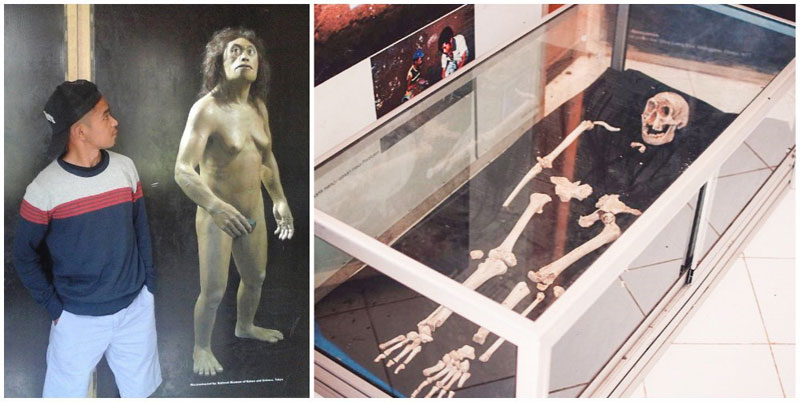
Photo Via Rizal_Goenawan,Michaelsaf
Excavations and research at Liang Bua are still going on. Hopefully, one day, we'll understand more about human evolution. But until then, the cave will keep its secret and all we can do is speculate.
Hobbit cave (Liang Bua cave)
Entrance fees: the ticket to the museum costs Rp 40,000 (Approximately USD 3)
Address: Liang Bua, North Rahong, Manggarai Regency, East Nusa Tenggara
Getting there: The cave is located about 14 km north of Ruteng (less than 40 minutes' drive). You can take an ojek (unofficial motorbike taxi), rent a car with a driver or take the public transport from the Kota Ruteng Terminal (costs about Rp 7,000 but it takes a little longer than car or motorbike)
Opening hours: Not fixed, but if you have a driver or guide and the museum seems closed, they can help you track down the person-in-charge
6. Overlooking the lush green: Spider web rice fields (view from Golo Cara village, west of Ruteng)
On your way to Ruteng, you can do a little stopover like we did, and spend some time soaking in this beautiful view.
As I stood there, I couldn't help but wonder why the villagers decided to shape the rice fields this way. The guide explained to us, that it is not just for viewing pleasure.

Photo Via Febriantoarbi
The true reason is that the land is owned by the entire community of people from Manggarai regency, unlike other land in Flores.
The individual parts are divided by members of the community according to their status in the village and the number of their family members. The higher the status and the larger the family, the larger the portion of the fields would be given to them.
So it actually made sense to mold the fields into a shape that resembles a spider web.

Photo Via Suwandicphoto
To reach the viewpoint, you'll need to climb a few steps. But it's an easy climb for a few minutes, and if you're on a road trip it's a nice motivating factor to stretch your body and breathe in the fresh air with the gorgeous view in front of you.

Photo Via Manasyeriant
Spider web rice fields
Price/Entrance fees: Rp 15,000 (Approximately USD 1)
Address: Cancar, District of Ruteng, Manggarai regency, Flores Island, East Nusa Tenggara Province, Indonesia
Getting there: The spot is located 20km west of Ruteng, near the village of Cancar. Coordinate here
Opening hours: Do come before the harvest season, when the fields have the nicest colour
7. A living museum: Bena Village (visit from Bajawa, Ngada)
Bena, one of the most visited traditional villages in Flores, a place where centuries-old traditions are kept.
The village consists of 45 houses called "bhaga". You can see human figurines on the thatched roofs and the doorways are decorated with buffalo skulls. Every time a house is renovated, one more skull would be added.

Photo Via Pergidulu,Soniaprobowo
The houses are arranged in two rows and in the space between, there are graves, stone monuments, and in the village centre you will find a sacred sanctuary – Ngadhu and Bhaga.
These carved tree trunks represent the natives' ancestors. Ngadhu, the symbol of fierceness and masculinity, represents the male element, and Bhaga represents the female ancestor.
When we reached the end of the village, we were surprised by the stunning view – we could see Mount Inerie and the Savu Sea, with the view of Bena village behind our backs!

Photo Via Mutmut1
Bena village is home to nine clans living in 45 houses and even though modern technology has invaded the land (there's televisions and mobile phones), the villagers are still trying to maintain their 1,200-year-old traditions.

Photo Via Dianmadonna

Photo Via Linayanty
You can watch them in their everyday life – farming, making traditional ikat (tube sarong, which you can buy from them), chewing betelnut (which is the reason why some of them have bloody teeth), and kids playing outside.

Photo Via Aryadillah.S,Jessicalucyadams
Bena people are very friendly and even though they have their own language, Ngada, most of them understand Bahasa Indonesia. So if you can speak a bit of the latter, they will be able to chat with you, or even invite you into the house for a cup of coffee brewed from homegrown beans.
Most of the citizens converted to Catholicism, but others still worship ancestors and practise rituals such as animal sacrifice.
The best time to visit is the end of December, during the week-long Reba festival, where the villagers gives thanks to God for the year's good harvest by singing and dancing in traditional ikats.
Bena Village
Price/Entrance fees: Rp 25,000 (Approximately USD 1.90) or Rp.125,000 per person if you decide to spend a night there
Address: Nusa Tenggara Tim., Tiworiwu, Jerebuu, Kabupaten Ngada, Nusa Tenggara Tim.
Getting there: Bena is situated 12km from Langa, a traditional town 7km from Bajawa. You can take an ojek ride there for Rp.70,000
8. Experience the Penti Festival & stargaze at Wae Rebo village
Wae Rebo is one of West Flores, Manggarai's oldest traditional villages, most well-known for its exquisite cone-shaped housing. The village is located on an idyllic mountain, and requires a some stamina to arrive at – don't scoff at a five-hour hike.

Photo via menujutimur.com
But once you're there, you'll get to interact with the indigenous Wae Rebo people, and even stay overnight in one of the traditional thatched houses!
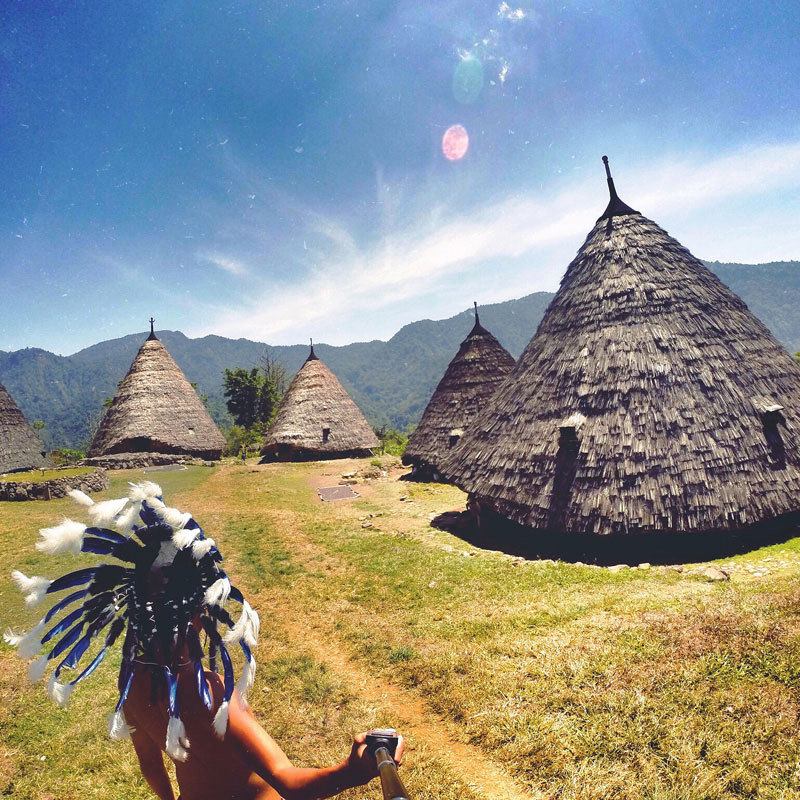
Photo by Asoka Remadja
Arriving during the Penti Festival (the Wae Rebo people's New Year's Eve) in November will give you a special chance to understand more about this ancient culture.

Photo via: campatour,-khiri.
And after you spent 5 hours hiking up a hill and panting your way to the village – surely you're not just going to catch a good night's sleep and leave, right? Especially not when you're at a great vantage point; perfect for some late night stargazing.

Photo via: byrubenkristianto
Asoka himself testifies to the unearthly beauty of the Milky Way as seen from the hilltop, and we agree. We don't think there could be any dream that could unseat this view from its throne of beauty.
Just sacrifice a few hours of your sleep. You won't have any complaints (at least until the next day), trust us.
(Tip: It is recommended that you bring your own water supply to the village though, as your body may not be used to the water sources that the locals drink from.)
Wae Rebo Village
How to go: From Labuan Bajo, take a car/motorbike/truck to Ruteng, then Denge, where you have to start your hike up the mountain. The trip from Labuan Bajo to Denge typically takes 7 – 8 hours, while the hike would take another 3 – 6 hours.
9. All the pretty sparkly shades on the shore: Blue stone beach (near Ende)
You may have seen a black sand beach or pink beach, but what about a beach with different shades of blue?
The turquoise pebbles of Blue Stone beach create a splendid mosaic, and together with the green misty mountains of Bajawa in the background, it's an astonishing sight!

Photo Via Irwannurdin
Ranging from blue, green to red, the pebbles received their unique colours thanks to the similar-coloured cliffs that they originated from.

Photo Via Somewhereniceblog,Catharinanovaqua
These colourful stones are a good source of income for the locals. They often collect them, sort them by size and colour to sell afterwards. The pebbles can be used for jewellery or any other decoration.

Photo Via Silviana_Esp
Blue stone beach (Penggajawa Beach/ Pantai Batu Biru)
Price/Entrance fees: none
Address:Penggajawa, Nangapanda, Ende Regency, East Nusa Tenggara
Getting there: The beach is located 25 kilometres northwest of Ende, on the road to Bajawa. The drive takes about 30 to 40 minutes.
10. Watch the sunset with hundreds of flying foxes: Kalong island (near Labuan Bajo)
The mangrove forests in Kalong island are inhabited by thousands of bats.
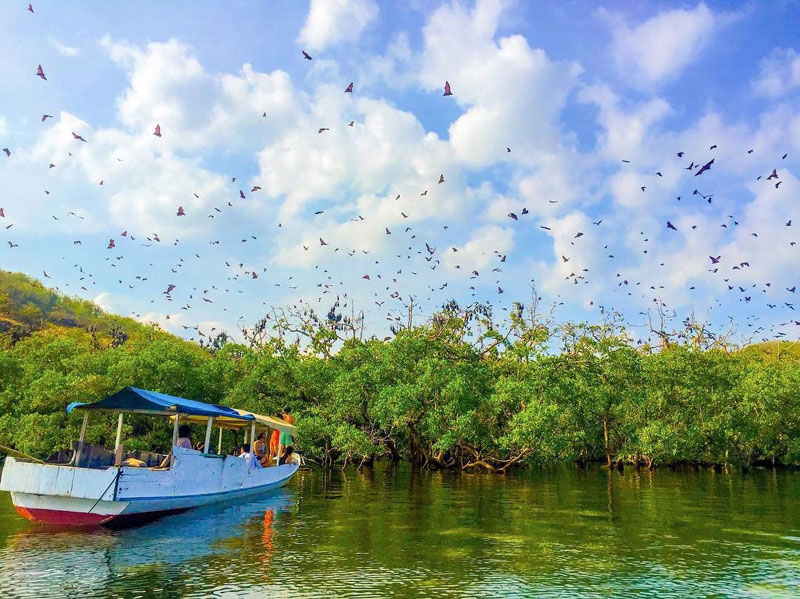
Photo Via Cyn_iskandar

Photo Via Travel.paullie,Rebel_rabbit
When the sun goes down, it's waking time for the bats, and you can see hundreds of them flying out from the forests in a synchronised flight, their dark silhouettes casting a dramatic shadow in the orange glow.

Photo Via Michahuray

Photo Via Juliesofieo
Kalong island
Getting there: Kalong Island is located 8 km from Labuan Bajo port, and the boat ride takes about 1 hour.
11. Join in the lively Good Friday procession and Semana Santa in Larantuka
If you are searching for a place with European influences, you would find it in the little village of Larantuka. The Portuguese settled there in the 15th century and it is often called "the place where Catholicism flourishes".
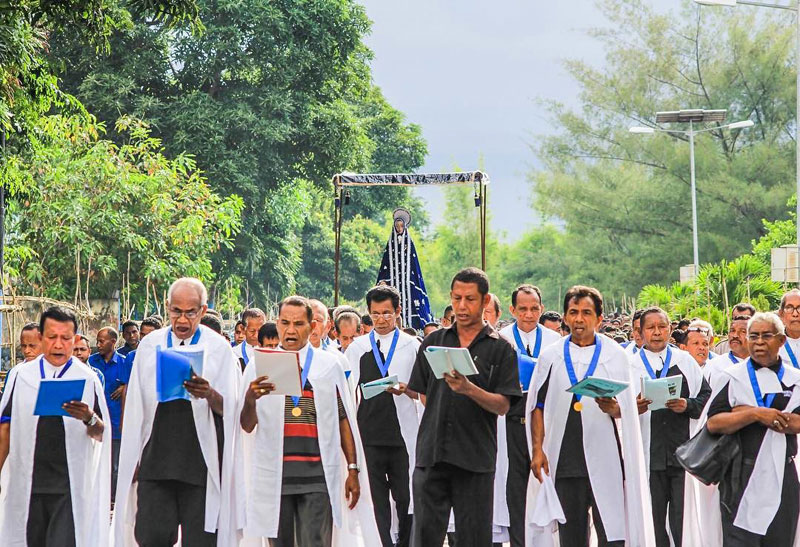
Photo Via Yr_Jong
During the week before Easter, quiet Larantuka transforms into a lively and busy village full of pilgrims. That's when the Semana Santa Holy week celebrations begin!

Photo Via Bozz_Fian,Davlians
It all starts with Rabu Trewa (Shackled Wednesday), when Larantuka turns into the Town of Mourning, as people pray in the chapels and remember Jesus' betrayal by Judas Iscariot.

Photo Via Tantular
The climax of the celebrations is the Good Friday procession, a 7-kilometre long walk, when a coffin of Christ is being carried from one altar to another through the streets lined with candles. The statues of Jesus Christ and Virgin Mary are also presented to the public on this special occasion.

Photo Via Andre_Agasi_Sigalingging
Another celebration that takes place during the Holy week is the Mama Muji – a woman's celebration.
Larantuka village
Getting there: To get to Larantuka, you can take a bus or car from Maumere (it takes about 3 to 4 hours). The bus costs about Rp. 80,000 (approximately USD 6) while a private car costs around Rp.450,000 to 500,000. (USD 34-38)
12. Meet the modern dinosaurs: Komodo National Park
Have you always dreamed of stepping into Jurassic Park?
Now – you have your chance at theKomodo National Park, where you can meet live roaming giant lizards, descendents of these extinct monstrous creatures. And this is usually the main draw for travellers to visit Flores.
We went on a boat tour from Labuan Bajo to explore this national park (the recommended method).

Photo Via M_Ggocheva
Our first stop was Padar Island, which has a surreal photogenic viewpoint.

Photo Via Valeriedsmt
When the boat arrives at Komodo island itself, get ready to meet the dinosaurs! Your guide will take you to locations where you can spot these giant lizards.

Photo Via Navidnaghdi,Juliaxjchiang
With a bit of luck, you can spot them sunbathing, drinking from the spring or simply just crawling about. We were quite lucky that day and saw three of them.
You'll also stop by Rinca, a smaller island with more dragons, but according to our guide, you should be able to spot them more easily on Komodo island.
Full day trips usually include a short stop at the pink beach where you can snorkel and get some rest. The pinkish shade is caused by little pieces of red coral that mixes with the white sand.
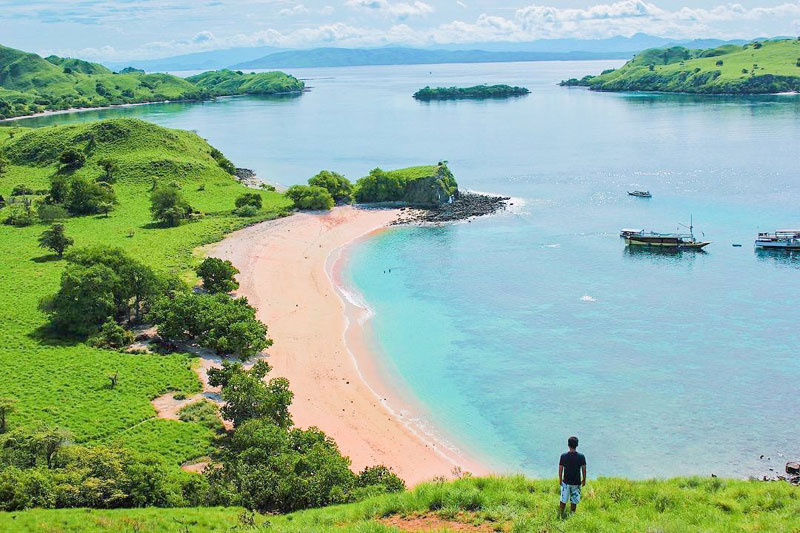
Photo Via Erictanoto

Photo Via Backpacker.id,Fairuzair
Komodo National Park
Price/Entrance fees: A one-day boat trip will cost you about Rp. 500,000 (USD 37) per person and the entrance fee to Komodo island is Rp. 250,000 (USD 18.60) per person
Getting there: Organize a boat trip from Labuan Bajo
13. Mirrors in the stone: Batu Cermin cave (near Labuan Bajo)
Discovered in 1951 by the Dutch archeologist, Theodore Verhoven, the Batu Cermin Cave is nicknamed "Mirror Cave" due to a magical phenomenon – as sunlight passes through the cave, the light is reflected from one stone wall to another, which creates a mirror effect!

Photo Via Neshaardella
This is because the stone contains bits of salt, which reflect the light like a mirror. The stone covers an area of 19 hectares and the cave is about 75 metres high and 200 metres long. To see the sparkling stone, you'll have to go down to a depth of 20 metres.

Photo Via Tamiangtobing
During the rainy season, it's even possible to see the reflection of water puddles on the cave walls!

Photo Via Wiranurmansyah
The cave is also covered with sparkling stalactites and stalagmites, and as it has once been submerged in the ocean, you can find fossil corals and turtles in the cave walls too!
Batu Cermin cave
Price/Entrance fees: Entrance fee costs Rp. 10,000 (USD 0.70) and a guide costs Rp. 20,000 (USD 1.40)
Getting there: The cave is located 4 km from Labuan Bajo. If you bike through the forest, it will take you about 30 minutes. Then from the parking area, you will have to walk for about 10 to 15 minutes to reach the cave.
14. Buy traditional handmade ikat from ikat weaving villages
You can't leave Flores without a handmade traditional ikat!
In many villages, the ikat is still made in an old, traditional way, using only natural resources. Some are made into a tube dress! Many people collect it for its beautiful colours and patterns. And by buying ikat, you're not just getting an organic handmade souvenir, but supporting the local community too!
14-a) The traditional: Watublapi village (Sikka district)
Unlike many other communities, Watublapi village stayed faithful to the old traditional methods. To create ikats, they use handspun yarn made of local cotton and natural dyes from the plants grown in their garden. Locals will show you each step of the ikat weaving process, and if you want to learn to make it yourself, you can join a workshop too!

Photo Via _Orinila,Inezwulandari
To get the best experience, register in advance and you will be welcomed by a traditional dance and music performance or even a betelnut chew!

Photo Via Nikeariesthaa
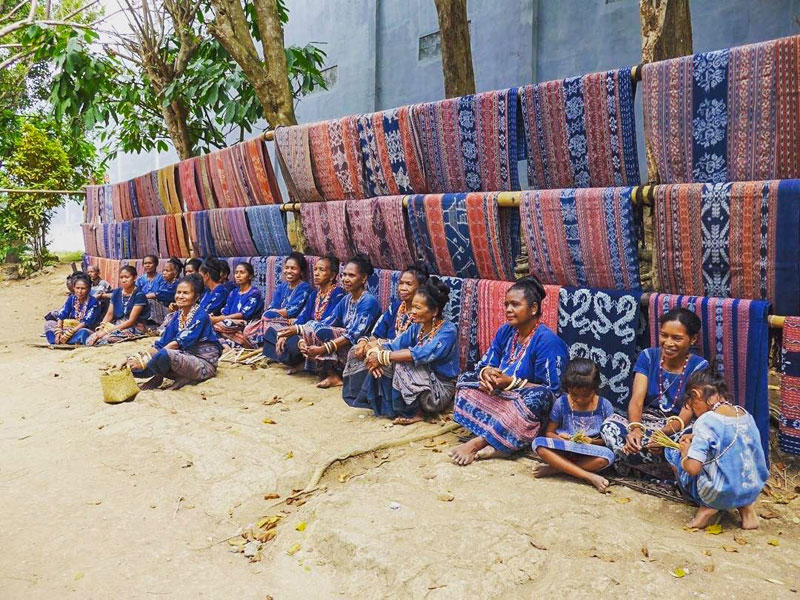
Photo Via Threadsoflifebali
Watublapi village
Address: Watublapi Village, outside Maumere City, Watublapi, Flores, Indonesia
Getting there: Watublapi Village is located east of Maumere. You can get there by car or motorbike. About 7km from Maumere, pass Geliting Market. And 100m from the market on the right, there is a sign to St Gabriel Hospital. Follow the road and after 13km, you will arrive in Watublapi, with its bamboo entrance gate on the left.
14-b) Women power: Ndona village
The Ndona community of Bou Sama Sama, led by Ibu Maria Angelina, creates beautiful naturally dyed ikats, especially the red ones, which are dyed using extracts from the morinda tree.

Photo Via Laauraarafat

Photo Via tripwizanna, nartodiubud, laauraarafat
Ndona village
Getting there: Ndona village is only around 5km (around 20 minutes) from Ende. It is recommended to get there by private transport as there is no public transport available.
Contact: Make an appointment with Ibu Maria Angelina (+62 81230493067)
14-c) Traditional art weaved into Catholicism: Sikka Village
Sikka Village is one of the most important weaving centres in Flores. It is the only place where you can see the blend of traditional art with Catholicism brought in by the Portuguese. Even the walls inside the church of Sikka are decorated with ikat motifs!

Photo Via Estitanaem,Josephwolfgang
During Christmas, you can watch the dramatic Toja Bobu dance, also influenced by the Portuguese.

Photo Via Engeltanzil,Florestourism

Photo Via Adriannabels
Sikka Village
Getting there: You can get to Sikka Village by car, motorbike or minibus. From Maumere, take the road to Ende. After about 23km, you will see a signpost with 'Kampung Sikka' written on the left side of the road. Head in the direction of the signpost for about 7km until you reach the village
14-d) For the shell lovers: Lewokluok village
All ikat collectors must have the unique ones from Lewokluok village – the ikats are decorated with seashells that villagers collect from the shores!

Photo Via Jareteddy

Photo Via Florestourism
Lewokluok village
Getting there: There's no public transport that passes through Lewokluok. By car or motorbike, you need to drive for about 26km from Larantuka and 114km from Maumere. The road off the Trans-Flores highway that leads you to Lewokluok is another 2km.
15. Uncover spectacular waterfalls
With such beautiful landscape in Flores, how can you not check out the flowing waterfalls?
15-a) Canoe through the rainforest: Cunca Wulang Waterfall

Photo Via Dresnoja

Photo Via Captain_potter
Situated in a tropical rainforest, Cunca Wulang is often searched for by canoeing enthusiasts. You can hike here and swim in the natural pools!

Photo Via Hari_arch

Photo Via Daramau
Cunca Wulang Waterfall
Price/Entrance fees: Rp.75,000 (USD 5.60)
Address: Pota Wangka, Boleng, West Manggarai Regency, East Nusa Tenggara
Getting there: Cunca Wulang Waterfall is located in Wersawe Village, Mbeliling District, Manggarai Barat Regency, East Nusa Tenggara Province. Follow the main road from Labuan Bajo to Ruteng. After 26km, you will reach Cekonobo where you have to turn left, and head downhill towards Wersawe Village. It is 4km from the main road crossing to Wersawe.
15-b) Weave through the hills and rice paddies: Tengkulese waterfall
On the way to Tengkulese waterfall, you will walk through landscapes with lush green hills and paddy fields. And before you know it, this huge 100-metre-high waterfall would appear in front of you.

Photo Via Etotagur,Selvilicious
We don't recommend jumping directly into the water, as the currents can be very strong. A safer alternative would be to follow the stream, and you'll find smaller natural pools where you can have a dip in!

Photo Via Riyanh.id
Tengkulese waterfall
Getting there: From Ruteng, it is about a two-hour drive to reach the starting point of the hike. There are a number of routes that lead to Tengkulese waterfall, but the shortest recommended one is from Liang Bua, which is only 15km away. From Ruteng to Liang Bua, add another 13km. The best option is to go there by a private vehicle (car or motorbike). The access road ends at Nanu Village. From there, you will have to walk for about 2.5km to get to the waterfall.
15-c) Through unexplored traditional villages: Murusobe waterfall (twin waterfalls)
There are three adventurous hiking trails that will get you to Murusobe waterfall, either via the Trans-Flores highway, from Lekebai village or from the Northern Road via Deturia village.

Photo Via Willyyant
Each of them will lead you through untouched traditional villages, before reaching the immense waterfall.
Mushobe waterfall
Getting there: Either via Trans-Flores, from Lekebai village or from Deturia village.
16. Paradise found: 17 islands Marine Park
What do you imagine when you think about paradise? Crystal clear water, coconut palm trees, isolated white sand beaches, with deep ocean stretching out into the horizon? 17 islands have it all!

Photo Via Stevi_Ariguna

Photo Via Rositaonthebike
This coral garden national park actually consists of 20 islands, and were said to be named after the day of Independence in Indonesia (17th August). Another legend behind the name is about a 17-year-old Indonesian girl.
A one-day boat trip is a best method to explore as much as you can. Find your guide in Riung.

Photo Via Dolyadhansyah
If you have a passion for snorkeling, the best spots are in Pulau Bukit Tiga and near Pulau Mborong. The rich coral-reef ecosystem offers a spectacular view of 27 different coral species, thousands of colourful fish, starfish and turtles. If you are lucky, you may even spot dolphins or whales from your boat.

Photo Via Myrte.Dejonge

Photo Via Lasugondo,Singgihy
17 islands (Pulau Tujuh Belas)
Price/Entrance fees: the boat trip costs Rp.550,000 to 800,000 (which includes guide, boat captain, snorkeling gear, lunch and water), and around Rp.20,000 parking fee
Getting there: Take a boat trip from Riung, located approximately 72km from Bajawa. To get to Riung, you'll have to take the Trans-Flores highway, either from Mbay (about 2 hours), Bajawa (4 hours) or Ende (3-4 hours). A bus will arrive twice a day from Bajawa (called Gemini), but the travelling time will be longer. You can also rent a car (with or without a driver).
17. The ancient home of the royal clan: Todo traditional village in Manggarai (1 hour before Ruteng)
The ancient royal village of Todo has a history that goes back centuries ago, when a king named Mashur and his clan came from Sumatra and decided to settle down in this village. And since then, until the Dutch took over, Todo was the center of Manggarai administration.
Now you have a chance to visit this ancient royal village and get a peek into the lives of the villagers. The village is situated high up in the mountains, so it offers a beautiful view all around.

Photo Via Popinzaz
Manggarai culture is characterised by the use of circular forms. You can begin your walk from Watu Todo, the ritual stone, that guards the village and symbolizes its power. Follow a stony path and you'll get to the "compang", a circular construction made of rocks. Continue to the ceremonial house, where they worship the ancestors.
Here, you'll fine thatched houses that are about 25 metres in diametre. As you walk in, you'll notice that the entrance and pillars in the house are decorated with lovely wood carvings. You will also find ritual heirloom drums and gongs!

Photo Via Pergidulu
The Todo village is full of myths and legends. One of them tells a story of the "mother drum". It is believed that the drum was made from a young girl's skin. The girl was killed by a man of the royal clan, who committed the murder as he didn't want her to marry another king.
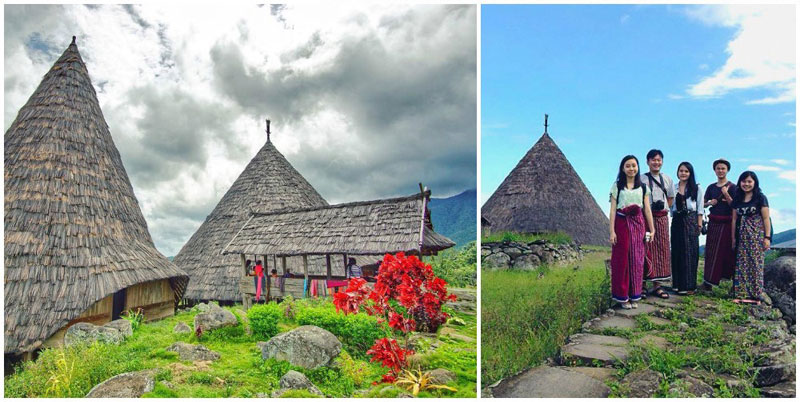
Photo Via Soniaprobowo
The villagers take this drum out only during special ceremonies or for tourists who are willing to pay huge sums of money.
Todo village
Price/Entrance fees: Rp 50,000 (Approximately USD 3.70)
Getting there: Todo Village is situated 36 km (about 2 hours' drive) southwest from Ruteng. From Ruteng, head north to Golo Lusang. After having passed by Golo Cala, turn right to Pongkor. Pass through Papang and Ulungali Village. From there, cross the Wae Mese River via the long bridge and pass through Popo Village before reaching Todo. Public transport from Ruteng to Todo starts from Mena Bus Terminal in Ruteng and will take about 2.5 to 3 hours.It is also possible to get there by motorbike, but be aware that the last part of the road is quite challenging. Take the main road, go west for about 30km, then follow the sign to the village.
18. Only for the brave ones: Snake Palace Cave (West Flores, near Lembor Manggarai)
If you are a snake lover, you will love the Snake Palace Cave – a dark, dank cave with a long tube that is hundreds of metres long, which is actually home to snakes (including pythons and other dangerous species) and thousands of bats.
The local villagers tell many legends about this mystical place. It is believed a huge snake resides at at the end of the tube, and its skin has faded to white because it never goes out of the cave. They also claim that during the rainy season, the snakes emerge from the cave to prey on dogs and chickens in the village. The locals would say a prayer or even leave a chicken as a sacrifice for the snakes before they enter the cave.

Photo Via Jamal-Junior
To go in, you will need to do a bit of hiking along the slippery muddy path, so it can be pretty challenging.
Even if you are really fearless, it is strictly prohibited (and also dangerous) to visit the cave without an experienced guide. Make sure visit during the dry season (from April to October), as the cave can be flooded otherwise.

Photo Via Flores-Explore
Be warned that the bats in the cave are also known to carry Australian Bat Lyssavirus and antibodies to Hendra virus.
Snake palace cave (Istana Ular)
Getting there: The Snake Palace cave is located in Daleng village, 70 km (around 2 hours' drive) east of Labuan Bajo. It is in between Labuan Bajo and Ruteng. To reach the cave, you'll need to hike for 40 minutes to the valley, and hire a guide either in Lembor or Daleng village.
19. Exotic dives with strange marine creatures
For those who like to explore the underwater world, there is no better place than crystal clear waters around Flores! Dive into the depths of the ocean and swim with mantas, turtles, seahorses and hundreds of fish!
19-a) Dive with manta rays: Karang Makassar (Manta Point)
Diving with mantas will pump some adrenaline into your blood! These huge animals will swim all around you, so close that you can even touch them!

Photo Via Sari_Mulyo

Photo Via Thecoastalcampaign

Photo Via Eksatnug

Photo Via Everything.Photographic,Max_Tjoa
Karang Makassar
Getting there: The island is located between Komodo and Rinca. You can organize a diving boat trip from Labuan Bajo.
19-b) A blessing in disguise?: The Crack (Babi island, Sikka)
In 1992, an earthquake formed a 70-centimetre-wide and 30-metre-long crack located 20 metres underwater, which actually stretches all the way to the beach.

Photo Via Isak_stormrage
You'll meet eagle rays, hammerhead sharks, spider crabs, star pufferfish, boxfish, leafscorpiom fish, dartfish and even octopus!

Photo Via Yudhistbolenk
The Crack
Getting there: The Crack is located in Maumere Bay, and the best option is to organise a boat trip (eg. from Maumere)
19-c) Night dive: Seraya Kecil (near Labuan Bajo)
In Seraya Kecil, you can do a night dive. The currents are not strong here, so it's ideal for beginners. You can spot pygmy seahorses, turtles, stonefish or eagle rays here.

Photo Via Bmjlink

Photo Via Famayya
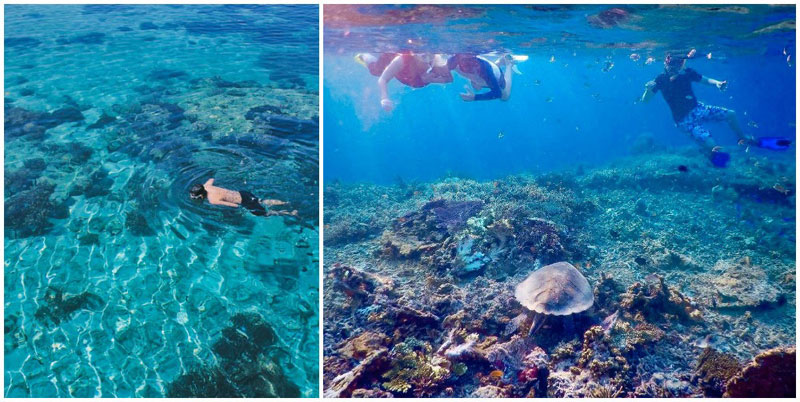
Photo Via Syawqii,Mrs__Bille
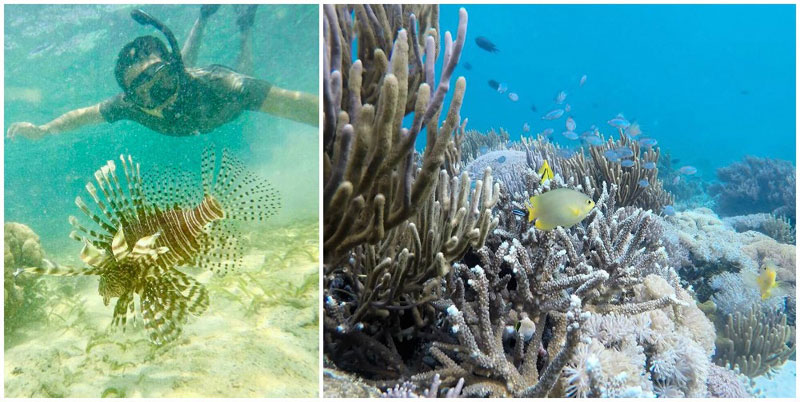
Photo Via Citra_Tayuwijaya,Andhikabayu88
If you are an experienced diver, you can go deeper, and with a bit of luck, you might even meet a reef shark or giant sweetlips.
Seraya kecil
Getting there: You can get there with a boat from Labuan Bajo
19-d) Not for food: Fish Soup (Pangabatang island, Sikka)
Like being in a bowl of fish soup – that's how it feels like to dive here.

Photo Via Armanmberu

Photo Via Vallejardo
Fish soup usually has very strong currents that attract huge schools of fish. Red tooth triggerfish, wahoo, mackerels, rays and sharks occupy the green coral gardens.

Photo Via Vallejardo

Photo Via Akiongtham,Istanbulakvaryum
Fish soup, Pangabatang Island
Address: Pulau Pangabatang, Parumaan, East Alok, Sikka Regency, East Nusa Tenggara
Getting there: By boat from Maumere.To experience all four exotic dives, you only need to go on two diving trips. The first departing from Labuan Bajo will take you to Manta Point and Seraya Kecil. The second will take you to The Crack and Fish Soup from Watumita. You can check out this diving centre.
20. Soak in natural hot springs near Bajawa
After all the trekking, hiking, diving and snorkelling, what can be better than a nice soak in a natural hot spring?
Not many tourists know that there are these "natural spa" near Bajawa. The springs are believed to possess healing properties, so you can soak your aching back and feet after a long trek!
20-a) Natural skincare: Malanage hot springs
Completely natural and unaltered bubbling pools – that's what your body needs.

Photo Via Roxysavage
There are two currents – a hot one from the volcano and colder one that is mixed with river water. Rich in sulphur, the water is actually beneficial for your skin!

Photo Via Eazytraveler
Malanage hot spring
Address: Malanage hot spring, Dariwali Village, District Jerubuu, Ngada district
Getting there: Located along the Bena Village access road from Bajawa, proceed for 2km after passing Bena Village, and head on to Dariwali Village. The springs are located a short distance off an unpaved road in Naruwolo Village. From there, it's a short hike down to the springs along a well-formed trail. Alternatively, you can take a 1-hour trek from Gurusina Village. If you don't have a guide, the locals will point you in the right direction.
20-b) Bathe in natural greenery: Mangeruda Soa hot springs
This hot spring is popular among the locals due to its healing properties and beautiful natural scenery all around!

Photo Via Tantimalasari

Photo Via Dedy_aqilla

Photo Via Charismaamgyn
Mangeruda Soa hot spring
Getting there: To reach Mengeruda hot spring, you can take a bemo (small public bus) that runs regularly to Mengeruda Village or any other rental transport from Bajawa. Mengeruda hot spring is located in the Mengeruda Village of Soa sub-district, approximately 25 km from Bajawa. You have to pass by quite a few villages – Naru, Menge, Boba, Gou, Nepa and Soa.
21. Experience age-old traditions in one of the oldest village: Tutubhada village
Few visitors have heard about Tutubhada village, one of the last villages where traditions are still being kept alive.

Photo Via Farricksan
At the top of the hill sits 14 houses called Sa'o Ji Vao. (In the local language, Sa'o means house, Ji is a word for strength and Vao means shelter.) The houses have uniquely shaped roofs and no walls. Their supporting poles are decorated with beautiful wood carvings and ornaments, while in the interior, you'll find cultural objects such as a Japanese cannon or buffalo heads.

Photo Via Umbertoverbita
When a new house is built, the villagers hold a special ceremony that involves a buffalo slaughter. The gate to the village is sacred – visitors are not allowed to touch it and they must enter with the right foot first.
If you are in Tutubadha in June, ask the locals when the time of "Etu" is – it's a traditional boxing event that can only be seen in central Flores.

Photo Via Brdgto
Tutubadha village
Getting there: Tutubhada is located in South Aesesa district, approximately 20km from the city of Mbay, the capital of Nagekeo regency.
Contact: Bapak Frederikus Balita, Village Head +6285333106518 or Mr. Willy Broduslasa, Promotion Division of Department of Culture and Tourism Nagekeo District +6285237917753
22. Taste Bajawa coffee in the local market
Bajawa coffee, known for its strong flavour and fragrance, is exported to many countries around the world and locals are very proud of it.

Photo Via Lontoleok,Cherrious
Usually grown using only organic products, the plantations in Bajawa are located about 1300 metres above sea level. The higher the plantations are located, the higher the quality of coffee produced would be.

Photo Via adieriyanto
Enjoy a steaming hot cup in one of the traditional villages in Bajawa with the locals, or buy some in the local market and bring it home as a souvenir.

Photo Via Ina_diah,Egieggo
Getting there: by bus from Labuan Bajo (Rp.160,000), Ruteng (Rp.80,000) or Ende (Rp.80,000)
23. Taste the traditional spirit: Arak Distillation in Aimere
Aimere is the manufacturing centre of arak, the traditional Indonesian spirit liquor. If you are interested to learn more about the process, make a stop in Aimere!
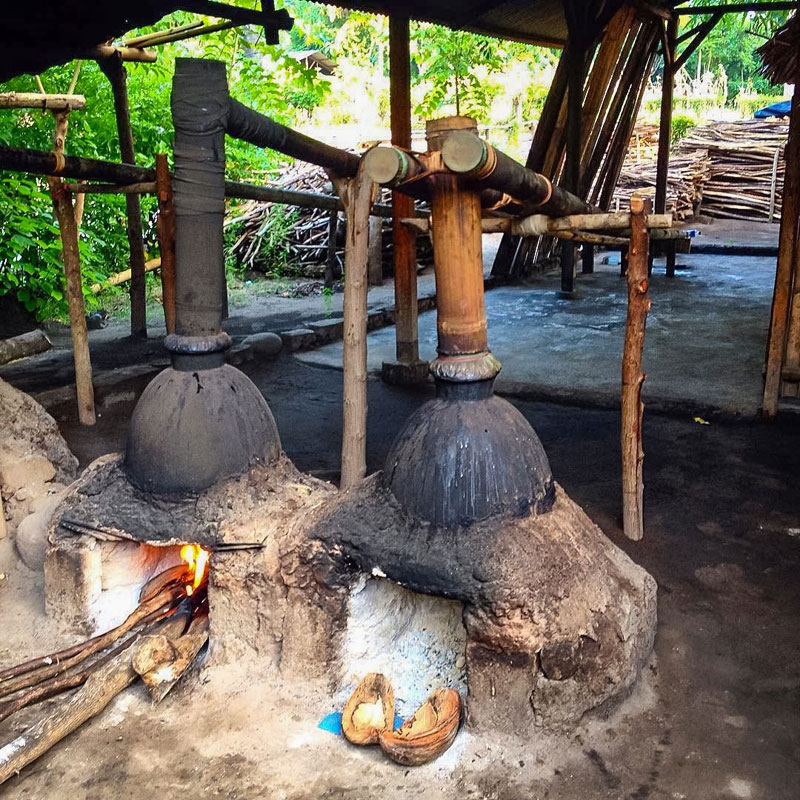
Photo Via Arisharvenda
Arak is made from palm wine, which is distilled in almost everyone's home. A traditional bamboo distilling system is still used, and locals collect the liquor in plastic bottles.
Sometimes, people add dead lizards or snakes into the bottles to give it that extra exotic oomph. Are you brave enough to try it?

Photo Via Danslongwayhome
Aimere
Address: Aimere, Ngada Regency, East Nusa Tenggara
24. Snorkel in crystal clear waters at pristine white sand beaches
Who can resist beautiful white sand beaches with crystal clear water? What's even better – quiet untouched beaches few tourists know about!
24-a) An almost-private island: Kanawa Island
Here, you can almost have an island all to yourself – isn't that a dream come true?

Photo Via Vf_inparadise

Photo Via Jenniferjuneha_
If you get tired of lazing on the beach, go grab your snorkelling equipment and explore the marine life on the reefs!

Photo Via Veru_dubova,Xiaomeiilee

Photo Via Janaplaznik,Yudipasaribu
Kanawa Island
Getting there: There is a boat service from Labuan Bajo to Kanawa Island at 12 noon every day, and the boat ride takes about 1 hour and costs Rp.100,000(USD 7.50)
24-b) Laze on the white sandy shore: Bidadari island
This beautiful white sand beach is ideal for a private getaway. You can stop here during an island-hopping boat trip to have a swim and enjoy the beach on your own!

Photo Via Nickoasmara

Photo Via Graciajuliaf

Photo Via Graciajuliaf

Photo Via Madebuanaputra,Prefransiskus
P.S. This has the same name as another island in Thousand Island (near Jakarta).
Bidadari island
Getting there: The island is located 30 minutes from Labuan Bajo by boat.
24-c) By the rock: Koka beach (Sikka)
A huge rock divides Koka beach into two smaller parts. Here, you can sunbathe, snorkel, explore the surroundings and enjoy a freshly cooked fish in a warung!

Photo Via Devineko

Photo Via Emilystotter

Photo Via Yvonneslagter
Koka beach
Price/Entrance fees: Parking fees Rp.10,000 (USD 0.75)
Getting there: You can drive to Koka beach from Maumere (48 km away), or from Wolowaru (35 km away).
25. Authentic immersion in the Manggarai local life: Mbalata beach (between Ruteng and Bajawa)
Apart from being surrounded by hills with a view of the majestic Mount Inerie in the background, Mbalata beach gives you a unique opportunity to experience and immerse yourself in the local rural life.

Photo Via Doroteagale,ThaiMy-C
You can stay at the Mbalata Inn Beach Cottages, which is not your ordinary accommodation.

Photo Via Doroteagale,ThaiMy-C
During your stay, you will get to see and interact with farmers working on the rice fields, learn how to make palm sap to produce traditional Manggarai liquor – moke, and you can join the elementary school kids as they clean up the beach.

Photo Via Infoaddict

Photo Via Infoaddict
Mbalata beach
Address: Watu Nggene, Kota Komba, East Manggarai Regency, East Nusa Tenggara
Getting there: Mbalata Beach is in Kotakomba, about 42 km east of Borong. The beach and the cottages are situated close to the Trans-Flores highway between Ruteng and Bajawa.If you come from Bajawa, especially Aimere, you will cross the bridge over the Wae Lengga river. After the bridge, look out for the sign to Mbalata Cottage Beach Inn on your left.From Borong, it will take almost an hour to get there (about 20 km). From this turn, also note that a white concrete gate serves as an entrance. The gate reads 'Welcome to Mbalata Beach', and leads you directly to a 300-metre-long stone-paved road to the beach.
Contact: 0813-3898-0163
Have you heard of any other must-visit unique locations in Flores? Do comment and let us know!
PLEASE NOTE: All the above information is correct at the date of publication. If you come across any changes or updates, please let us know and we will update the information accordingly. Thank you!
Tell us
| PLEASE NOTE: All the above information is correct at the date of publication. If you come across any changes or updates, please let us know and we will update the information accordingly. Thank you! Tell us |
Advertise with us
Source: https://indonesia.tripcanvas.co/flores/exotic-things-to-do/
Post a Comment for "Komodo National Park Funny Yahoo Answers"